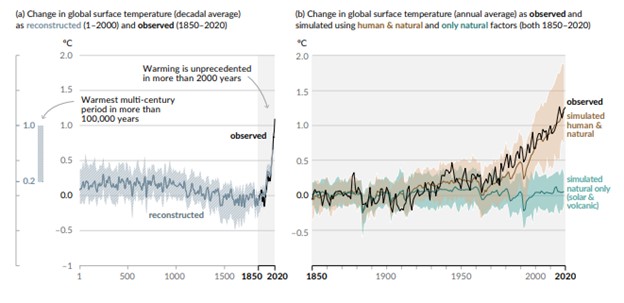The Climate Change Conference of the Parties in Glasgow, which ended in mid-November, was a significant milestone in the fight against global warming. Now, nearly two months after the end of the summit, after it has been displaced in the media by other topics, it is time to take a closer look at the strengths and the vulnerabilities of the agreements reached at the summit, and what else needs to be done to gain confidence that the right path is being taken.
Despite the limited number of participants and the vagueness of some of the phrasing in the agreements, the outcome of the summit invites cautious optimism.
First, there was a detailed joint discussion of climate problems by representatives of most countries of the world for the first time since the Paris Agreement. The absence of the leaders of China, Russia and Turkey at the summit is certainly not in favor of the event, but in any case, there is probably no country which can ignore its results.
Second, the Glasgow meeting took place in obvious recognition of real climate change with participants having near-full consensus as to its causes.
Third, the specification of programs for phasing out coal in the energy sector, reducing methane emissions, a declaration on forests and land use, and withdrawing support for fossil fuels will certainly have an influence on achieving the summit's targets.
Finally, the Glasgow summit took place in the face of another global danger, the coronavirus pandemic, which significantly diverted the necessary political and financial resources, as well as reduced the level of psychological perception of the urgency of tackling climate change. Still, the summit took place and was very productive, at least in terms of the volume of decisions agreed upon.
Now the question is to what extent the results achieved meet the urgent requirements to keep the global average temperature rise within 1.5°С of the pre-industrial level until 2050. According to many experts, this goal is already unattainable. More decisive and ambitious measures are needed. One of the main indicators that such conclusions are indeed justified is the IPCC international expert group's report "Climate Change 2021: The Physical Science Basis", released in August this year. Below you can find just a few takeaways from this report:
- «It is unequivocal that human influence has warmed the atmosphere, ocean, and land».
- «Each of the last four decades has been successively warmer than any decade that preceded it since 1850».
- «Human influence is very likely the main driver of the global retreat of glaciers since the 1990s and the decrease in Arctic Sea ice area between 1979–1988 and 2010–2019 (decreases of about 40% in September and about 10% in March) ».
- «Human-induced climate change is already affecting many weather and climate extremes in every region across the globe».
Changes in global surface temperature relative to 1850–1900
Source: Intergovernmental Panel on Climate Change
Some of the report's conclusions sound like a final verdict and sometimes even like an apocalyptic prediction, for example:
- «Global warming of 1.5°C relative to 1850–1900 would be exceeded during the 21st century under the intermediate, high and very high GHG emissions scenarios considered in this report…».
- «Based on paleoclimate and historical evidence, it is likely that at least one large explosive volcanic eruption would occur during the 21st century».
- «With further global warming, every region is projected to increasingly experience concurrent and multiple changes in climatic impact-drivers».
Most findings of the report are more or less known to the public, but usually only the most basic aspects of the problem. Many are also aware of the necessary measures to limiting future climate change, which were nevertheless reiterated in the report:
- «From a physical science perspective, limiting human-induced global warming to a specific level requires limiting cumulative CO2 emissions, reaching at least net zero CO2 emissions, along with strong reductions in other greenhouse gas emissions. Strong, rapid and sustained reductions in CH4 emissions would also limit the warming effect resulting from declining aerosol pollution and would improve air quality».
Now let us have a look at what was actually achieved at COP-26.
One of the main documents of the summit was the Global Coal to Clean Power Transition Statement. The countries whose authorized representatives signed this statement are shown on the map.
Member countries signed the Global Coal to Clean Power Transition Statement
Source: Based on Global Coal to Clean Power Transition Statement
Some countries, including, for example, Indonesia, have signed a statement with specific restrictions. In addition to them, representatives of individual territories, companies and organizations have agreed to the document.
Several key commitments have been made in the statement, including:
- «To rapidly scale up our deployment of clean power generation and energy efficiency measures in our economies, and to support other countries to do the same».
- «To rapidly scale up technologies and policies in this decade to achieve a transition away from unabated coal power generation in the 2030s (or as soon as possible thereafter) for major economies and in the 2040s».
- «To cease issuance of new permits for new unabated coal-fired power generation projects».
- «To strengthen our domestic and international efforts to provide a robust framework of financial, technical, and social support to affected workers, sectors and communities…»
This is a strong statement that could significantly change the current landscape of the electric power industry in the world, especially with regard to the refusal to approve new coal-fired power plants. However, there are also skeptical voices. Thus, according to the BP Statistical Review of World Energy 2021, in 2020 35% of the world's electricity, or 9421.4 Terawatt-hours, was generated from coal. Meanwhile, the share in coal generation of the world's first four largest producers who didn‘t sign the statement (China, India, U.S., Japan) was 76% or 27% of the total electricity generated in 2020 (26,823.2 Terawatt-hours). In addition, the first three countries noted above together produce 65% of the world's coal (159.61 Exajoules). If we add two other major coal producers, Australia and Russia, who also did not sign the statement, this share rises to 78%. As a result, the coal statement signed at the summit is of uncertain value.
However, things aren't that simple. Glasgow adopted another important statement – the Statement on International Public Support for the Clean Energy Transition. About 40 countries and organizations signed this document, including the USA, Canada, the UK, Sweden, the Netherlands. Perhaps the most important resolutions of this document were that the signing parties intend to "... end new direct public support for the international unabated fossil fuel energy sector by the end of 2022..." and "encourage further governments, their official export credit agencies and public finance institutions to implement similar commitments into COP27 and beyond.“ If this document receives real public acceptance and government support, the implications for the energy transition could be truly impressive. Lending institutions, equipment manufacturers, rating agencies, land-use agencies and environmental review bodies could use it as a guide to action. All of this can lead to serious restrictions on the financing and promotion of fossil fuel projects in many countries, including coal-fired generation leaders.
Another important document presented at Glasgow summit was the Global Methane Pledge to reduce methane emissions by 30% by 2030. The initiative was put forward by the USA and the EU, and more than 100 countries joined it. The participants' combined share of methane emissions is almost half of the total. China, India and Russia did not support the initiative, as they did in the coal agreement. Methane is the second greenhouse gas by the volume of emission after CO2. Its contribution to global warming is evaluated to range from 0.3 to almost 0.9 degrees Celsius. The peculiarity of this gas is that a significant part of its emission is due to natural processes (about 40% – IEA), and the rest is the result of various types of human activities. Among them, the main ones are agriculture, the energy sector and various wastes. The dynamics and level of methane emissions from these sources are shown in the following figure.
Source: Our World in Data
The energy sector has significant potential to reduce methane emissions. Suffice it to say that 140–150 million m3 of associated petroleum gas is flared annually in the world. Despite a decline in oil production in 2020, gas flaring volumes have increased in Russia, Algeria, Mexico, and Malaysia. The agricultural sector offers serious opportunities for reducing greenhouse gas emissions. For example, according to estimates made by the World Biogas Association, the production of biogas and biomethane can reduce GHG emissions by 10-13%. A huge amount of municipal waste in the world (about 30% – The World Bank) is still stored or burned in open landfills. All of these are the main areas where reliable statistical indicators, separate national and interstate programs, and proven technologies are available to reduce methane emissions. However, it should be taken into account that, for example, technologies for the utilization of associated petroleum gas are rather complicated, very expensive and require long-term investments.
The significant expansion of financial and technical support for the Global Methane Pledge announced by the U.S. and the EU certainly needs real confirmation. So far, it has been announced that charitable organizations have allocated little more than $ 300 million to support projects to reduce methane emissions, which is a catastrophically small sum. Taking into account the extremely short timeframe for the implementation of the goals stated in the Global Partnership statement - 8 years until 2030, it is obvious that the next year or two should be decisive in moving from promising declarations to the required practical and large-scale activities on methane utilization.
The summit also paid attention to another important area in the fight against climate warming: Accelerating the transition to zero emission vehicles. Since, on the one hand, road transport accounts for 10% of global emissions and, on the other hand, the vehicle production and distribution market makes up a significant share in the economy of many countries, any change in this area may have far-reaching and painful consequences. Obviously, this is why the participants of the established Zero Emission Vehicle Transition Council were limited to representatives from Canada, Japan, South Korea, India, Mexico, the European Commission, the most developed countries in Western Europe, and the state of California in the United States. Although they account for more than half of the global automotive market, the absence of China and the United States (at the state level), as well as Brazil, Russia, Germany and many others, from this list, greatly reduces the overall productive value of the declared statements. Nevertheless, some of them are very concrete and convincing. For example, from 2025 (Norway) to 2040 the participants are committed to allow the sale or registration of new BEVs and FCEVs only. Remember that the fleet of plug-in electric cars in the world is currently about 1% (electric cars currently make up 1% of the global fleet), and the best results are shown by Norway (over 17%), Sweden (4%), and the Netherlands (3%). Thus, even for the most advanced countries in this area, the set targets are impressive.
Next, we will closely follow the implementation of the summit's goals, as well as provide a special analysis of some of the organizational and technological barriers that are the greatest obstacles to reducing greenhouse gas emissions in the energy sector.
